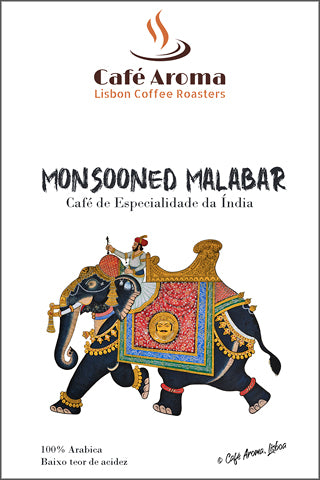
Coffee characteristics | Coffee designations | Origin of the coffee | The Label: The elephant in India
Coffee characteristics
This full-bodied coffee from the southwest of India has a very light acidity and notes of malt and nuts. A blend of AA-grade Arabica varieties has been processed using the monsooned method. It is a coffee speciality that owes its sumptuous character to the monsoon climate. Among coffee lovers, the India Monsooned Malabar has not been a secret for quite some time. It is very popular because of its blend of aromatic flavours on the one hand and its low acidity on the other.
Coffee designations
The Arabica varieties used for this Monsooned Malabar Coffee are called Kent, S.795, Catimor and Selection 9. These are excellent varieties typically used in India. The term "monsooned" refers to a special process of exposing the coffee to the warm and humid monsoon winds for days after harvesting. For more information, see "Origin of coffee" below. Grade "AA" is the best grade in India and corresponds to the sieve sizes 18.5 - 20, i.e. the largest possible sizes (except for the "Maragogype" variety). This coffee is a speciality coffee in the sense of the Specialty Coffee Association (SCA), where a coffee must score at least 80 points in the classification.
Origin of the coffee
In the early days of shipping, the clipper ships (cargo sailing ships) with their wooden vessels needed about six months to reach Europe, as they had to sail around the Cape of Good Hope on their way to London. Due to the extremely different climatic conditions during transport, the coffee changed its original characteristics: shape, colour, size and also its taste. After the invention of steam navigation and the construction of the Suez Canal, these changes in the green coffee disappeared and the English began to complain about it.
So the Indian coffee producers began to artificially copy this process of change in the green coffee during the earlier crossing. To this end, they still use the extreme climatic conditions of the monsoon on the west coast of the country. The hot and humid climate of the monsoon causes the qualitative changes in the coffee beans that produce the unique flavour profile of this coffee. The monsoon process consists of exposing the natural coffee beans to the warm, humid monsoon winds in layers about 10 to 15 cm thick in well-ventilated warehouses. This process is carried out on the west coast of India, using the winds from the Arabian Sea during the southwestern monsoon months from June to September.
The area of cultivation

The India Monsooned coffee comes from the southwest of India, from the Malabar province. The equatorial humid climate that prevails in this region is conducive to coffee cultivation. The beans from these plantations are among the best coffees in India. The cultivation altitude is between 1,000 and 1,400 m above sea level. The farm of our coffee from the TATA company is located near the city of Mangaluru (until 2014: Mangalore). It is an important port city in the south-western Indian state of Karnataka with a population of around 500,000.
How coffee came to India: Baba Budan - or the hot commodity from the Orient
Baba Budan – that is the legend of an Islamic Sufi saint in 16th-century India who discovered his enthusiasm for coffee on a pilgrimage through the Middle East. A drink that did not exist in his native India. But at that time, exporting coffee, especially germinable coffee seeds, was punishable by death! Baba Budan nevertheless accepted this high risk and smuggled the sacred number of seven germinable coffee beans from Yemen to India, because he no longer wanted to do without his coffee.
Back in India, Baba Budan planted these seven beans in his garden not far from the evergreen, flower-covered mountain ranges of Chikmagalur. And it was there that the great Indian coffee tradition began to flourish. In his honour, the second highest mountain in the Indian state of Karnataka and the entire mountain range were named after him: Baba Budan Giri (formerly: Chandra Drona Parvatha). Both are located in Chikkamagaluru district. The mountain range is part of the so-called Western Ghats, which extend from Gujarat in the north down to Kerala and Tamil Nadu and have a total length of about 1,600 km.
Link to my documentary: Baba Budan and the seven wonder seeds
The Label: The elephant in India
In Hindu culture and mythology, elephants are considered sacred symbols of peace, spiritual strength and power, removers of obstacles and givers of prosperity, luck, wisdom, memory and vitality. One of the most popular of India's Hindu gods is Ganesha, a jovial god of fortune with an elephant's head who is often given to pranks. He is considered the fighter of evil and obstacles, the god of success, education, wisdom and knowledge. He is the son of the god couple Shiva and Parvati.
Through the power of the creator god Brahma, Airavata came into being, the first divine elephant, who was to become Indra's vehicle animal. And just as the elephant Airavata belonged to the goddess Indra, so the elephant in general belonged to the Indian kings. In ceremonial state occasions they represented the symbolic mount of the king; in war they are the watchtower and citadel from which he directs the strategy of battle. But their most important task is to summon their supernatural relatives, the clouds, those heavenly elephants. This is why the Hindu kings kept elephants for the benefit of their subjects.
